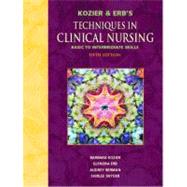
| Introduction | |
| Foundational Techniques | p. 1 |
| Health Assessment | |
| Vital Signs | p. 15 |
| Assessing Adult Health | p. 44 |
| Specimen Collection | p. 142 |
| Mobility and Safety | |
| Positioning the Client | p. 173 |
| Mobilizing the Client | p. 202 |
| Fall Prevention and Restraints | p. 222 |
| Maintaining Joint Mobility | p. 235 |
| Care of the Client in Traction | p. 250 |
| Assisting with Client Hygiene and Comfort | |
| Client Hygiene | p. 258 |
| Bedmaking | p. 287 |
| Infection Control | p. 297 |
| Heat and Cold Measures | p. 313 |
| Pain Management | p. 323 |
| Nutrition and Elimination | |
| Feeding Clients | p. 343 |
| Assisting with Fecal Elimination | p. 365 |
| Assisting with Urinary Elimination | p. 388 |
| Caring for the Client with Peritoneal Dialysis | p. 410 |
| Circulatory and Ventilatory Support | |
| Promoting Circulation | p. 417 |
| Breathing Exercises | p. 424 |
| Oxygen Therapy | p. 434 |
| Suctioning | p. 445 |
| Caring for the Client with a Tracheostomy | p. 458 |
| Caring for the Client with Chest Tube Drainage | p. 468 |
| Administering Basic Life Support to the Hospitalized Client | p. 480 |
| Medication Administration | |
| Administering Oral/Enteral Medications | p. 499 |
| Administering Topical Medications | p. 519 |
| Administering Parenteral Medications | p. 538 |
| Administering Intravenous Therapy | p. 578 |
| Wounds and Injury Care | |
| Performing Wound and Pressure Ulcer Care | p. 619 |
| Cast Care | p. 644 |
| Performing Perioperative Care | p. 654 |
| Table of Contents provided by Rittenhouse. All Rights Reserved. |
The New copy of this book will include any supplemental materials advertised. Please check the title of the book to determine if it should include any access cards, study guides, lab manuals, CDs, etc.
The Used, Rental and eBook copies of this book are not guaranteed to include any supplemental materials. Typically, only the book itself is included. This is true even if the title states it includes any access cards, study guides, lab manuals, CDs, etc.